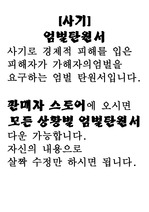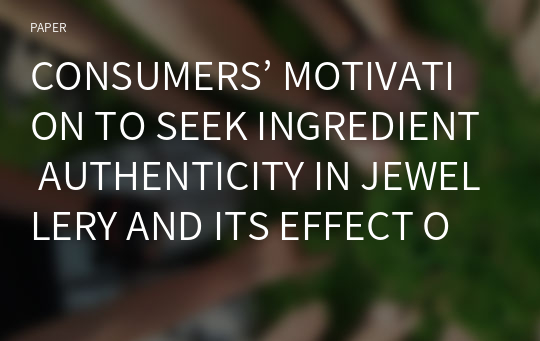CONSUMERS’ MOTIVATION TO SEEK INGREDIENT AUTHENTICITY IN JEWELLERY AND ITS EFFECT ON PRODUCT JUDGMENT AND WILLINGNESS TO BUY/RECOMMEND
* 본 문서는 배포용으로 복사 및 편집이 불가합니다.
서지정보
ㆍ발행기관 : 글로벌지식마케팅경영학회(GFMC)
ㆍ수록지정보 : Global Marketing Conference
ㆍ저자명 : Zahirah Zainol
ㆍ저자명 : Zahirah Zainol
영어 초록
This study aims to explore the motivations and effects of country of ingredient authenticity on product judgement and willingness to buy or/and recommend. Country of ingredient authenticity can be defined as set of consumers’ generic characteristics or traits of seeking/pursuing/consuming raw materials/goods and/or artisan skills that are deemed to be superior and synonymous to a specific location in the pursuits of one’s self image and social standing (Cheah, Zainol and Phau, 2017). The jewellery brands used in this study are Swarovski, Pandora and Monora. The 4X1 exploratory research design looks at four different conditions applied to the three jewellery brands. AMOS and SPSS were used to analyse the data and determine model fit. Managerial implications include the positive recognition of the ingredient authenticity of Swarovski crystals incorporated with other products/brands.Theoretical Development
Country-of-origin acts as a quality indicator (Bilkey & Nes, 1982). Consumers rely on their perceptions of product quality from a specific country to evaluate other products from the same country. The home country of a brand and its image can serve as a source of competitive advantage or disadvantage (Cuervo-Cazurra & Un, 2015). In more recent times, product collaborations and ingredient branding techniques have been adopted in the marketplace. As a first for its brand, Louis Vuitton partnered with Supreme to launch a streetwear line in 2017. In 2011, Prada launched a ‘made in’ campaign to highlight the authenticity of the raw materials and artisan skills used to create the products. Country-of-ingredient-authenticity aimed at exploring how countries can capitalize on their expertise to improve product and country image perceptions. The incorporation of materials and skills from the country-of-ingredientauthenticity can be a strategic decision that allows brands to alleviate the product judgement and willingness to buy or recommend (Suter et al., 2017). This decision can prove to be advantageous for the firm (Suter et al., 2018). This study aims to uncover whether Swarovski crystals, as both a raw material and artisan skill, can affect consumers’ perception of the product judgement and willingness to buy and recommend. The study also profiled the motivations of consumers’ seeking these ingredient-authentic products. In this research, statusseeking consumption and fashion knowledge act as the underpinning background variable to the model (Flynn et al, 2000; Eastman et al 1999). Luxury consumption is driven by the need for status in conspicuous luxury consumers whereas fashion knowledge in inconspicuous luxury consumers (Jaikumar, Singh and Sarin, 2018; Koo and Im, 2017). The study aims to discover whether status-seeking consumption and fashion knowledge has a significant impact on consumers’ need for seeking authentic ingredients in jewellery.
--------Insert Figure 1 and Figure 2 here --------
Research Design
In order to test our hypotheses, an online Qualtrics survey was created and administered to an Indonesian sample aged between 18 to 55 years old. Four sets of surveys were created to reflect the 4 different stimulus (Table 1). The study aims to look at whether the different brands paired with different ingredient authentic materials would result in a different perception of product judgement and willingness to buy/recommend (Maxham and Netemeyer, 2003; Bower and Landreth, 2001; Wood and Darling, 1993). The researchers were also interested to uncover the motivations behind the need for ingredient authenticity in consumers’ decision making to buy jewellery. The brands chosen were Swarovski, Pandora and Monora. Swarovski serves as the control to measure consumers’ response to the actual brand with the incorporated Swarovski crystals. Pandora was used as it is a well-known jewellery brand with a potential collaboration with Swarovski and Monora is a lesserknown jewellery brand whose brand and product quality could improve with the incorporation of Swarovski crystals. Respondents chosen had to be interested in or aware of luxury branded goods as it is important to possess some knowledge to seek for authenticity in luxury branded products. 600 completed surveys were collected in a span of 2 months. AMOS 21 software was used to run SEM model and test for model fit. SPSS 22 was used to run a median split and independent sample T-test to ascertain the motivations of ingredient-authenticity behaviour between low and high status seeking and fashion knowledge consumers.
--------Insert Table 1--------
Results
Four models were tested on AMOS to determine the model fit and its significant interactions.
Study One – Swarovski jewellery with Swarovski crystals
The conceptual model has achieved a good model fit with indices of χ2(94) = 128.937, p = .01. The other indices suggest adequate fit, SRMR = .0303, GFI = .910, IFI = .988, TLI = .985, CFI = .988, RMSEA = .049, PCLOSE= .510.
Study Two – Pandora jewellery with Swarovski crystals
The conceptual model has achieved a good model fit with indices, of χ2(34) = 63.490, p = .002. The other indices suggest adequate fit, SRMR = .0415, GFI = .933, IFI = .980, TLI = .968, CFI = .980, RMSEA = .076, PCLOSE= .071.
Study Three – Pandora jewellery with real crystals
The conceptual model has achieved a good model fit with indices, of χ2(54) = 56.332, p = .388. The other indices suggest adequate fit, SRMR = .0233, GFI = .945, IFI = .999, TLI = .998, CFI = .999, RMSEA = .017, PCLOSE= .900.
Study Four – Monora jewellery with Swarovski crystals
The conceptual model has achieved a good model fit with indices, of χ2(109) = 182.549, p = .000. The other indices suggest adequate fit, SRMR = .0464, GFI = .893, IFI = .975, TLI = .968, CFI = .974, RMSEA = .066, PCLOSE= .06.
A median split and independent sample T-test were carried out on low and high status-seeking and fashion knowledge consumers and their means compared to the ingredient-authentic seeking behaviours. Status-seeking behaviour is the main driver of consumers acting on the need for authenticity of raw materials and artisan skills on all 4 stimulus. This behaviour could be attributed by consumers’ hedonic need to own jewellery that signal good quality and design. Fashion knowledge consumers seek authenticity of raw materials and artisan skills in both Pandora stimulus and looked for authenticity of artisan skills in Monora stimulus. This indicates that owning a Pandora jewellery can be attributed to being a trendy fashionista following the current trend of collecting charms. As for the lesser known brand, Monora, the incorporation of the ingredient authentic Swarovski crystal helped consumers to identify the authentic artisan skill that goes into making the jewellery.
-------- Insert Table 2 and 3 here --------
Conclusion
Swarovski jewellery commands high interest in consumers seeking for ingredient authentic products as authenticity of artisan skills positively influences product judgement and authenticity of raw materials positively influences willingness to recommend. There was no ingredient-authenticity effect in consumers when exposed to Pandora jewellery with Swarovski crystals. Pandora has always been associated and known for the novelty of collecting the charm trinkets. Consumers are more likely to buy Pandora for their charms rather than the fact it is embedded with a Swarovski crystal. Pandora jewellery with real crystals was perceived positively by consumers to increase product judgement and willingness to recommend and buy. Again, the collectors’ mindset plays a role in this behaviour. The strong brand effect also plays well into Pandora’s popularity in the marketplace. Monora jewellery with Swarovski crystals piqued consumers’ interest in the ingredient authentic product with authenticity of artisan skills positively influencing product judgment and authenticity of raw materials positively influencing willingness to recommend. The results support the idea that when Swarovski crystal is incorporated into a lesser known brand’s product, it increases the quality perception and word of mouth value. On all four studies, consumers’ product judgment positively influences willingness to recommend indicating consumers are more willing to spread word-of-mouth when they believe the product is of good quality. This willingness to recommend then positively leads to willingness to buy the product. Status-seeking behaviour was seen as a main factor for consumers when searching for the ingredient-authenticity of the jewellery. For Swarovski and Monora, the ingredient played a part in inducing the ingredient-authenticity behaviour whereas owning a Pandora jewellery signifies some sort of in-class group reference and trend. The Pandora results are supported when consumers who have fashion knowledge also sought the ingredient-authenticity of the Pandora product.
참고 자료
없음"Global Marketing Conference"의 다른 논문
 THE ROLES OF GREEN PACKAGING IN UGLY FOOD PURCHASE INTE..22페이지
THE ROLES OF GREEN PACKAGING IN UGLY FOOD PURCHASE INTE..22페이지 THE IMPACT OF INDUCED AWE ON ETHICAL TOURIST BEHAVIORS5페이지
THE IMPACT OF INDUCED AWE ON ETHICAL TOURIST BEHAVIORS5페이지 A BIBLIOMETRIC ANALYSIS OF SPIRITUAL TOURISM RESEARCH15페이지
A BIBLIOMETRIC ANALYSIS OF SPIRITUAL TOURISM RESEARCH15페이지 SOCIAL NETWORK ANALYSIS AND RESPONSE TIME TESTING: CONS..11페이지
SOCIAL NETWORK ANALYSIS AND RESPONSE TIME TESTING: CONS..11페이지 THE EFFECTS OF PARA-SOCIAL INTERACTION ON ONLINE CELEBR..3페이지
THE EFFECTS OF PARA-SOCIAL INTERACTION ON ONLINE CELEBR..3페이지 THE INFLUENCE OF OPINION LEADERS ON DAILY DEALS USER’S ..3페이지
THE INFLUENCE OF OPINION LEADERS ON DAILY DEALS USER’S ..3페이지 HOW IMMERSIVE RETAILING AFFECTS CONSUMERS’ URGE TO BUY:..6페이지
HOW IMMERSIVE RETAILING AFFECTS CONSUMERS’ URGE TO BUY:..6페이지 KEY TO SUPERSTARDOM IN A GLOBALISED MARKET: THE ROLE OF..6페이지
KEY TO SUPERSTARDOM IN A GLOBALISED MARKET: THE ROLE OF..6페이지 A POST-PANDEMIC LOOK AT TOURISTS’ PERCEIVED COOLNESS OF..4페이지
A POST-PANDEMIC LOOK AT TOURISTS’ PERCEIVED COOLNESS OF..4페이지 EXTRACTING OFFLINE RETAIL SHOPPING PATTERNS: OLLABORATI..5페이지
EXTRACTING OFFLINE RETAIL SHOPPING PATTERNS: OLLABORATI..5페이지


























